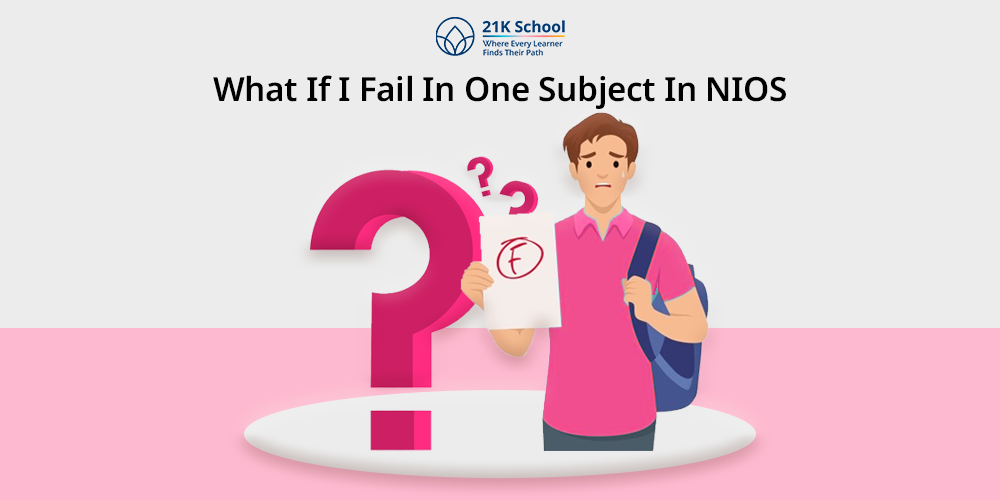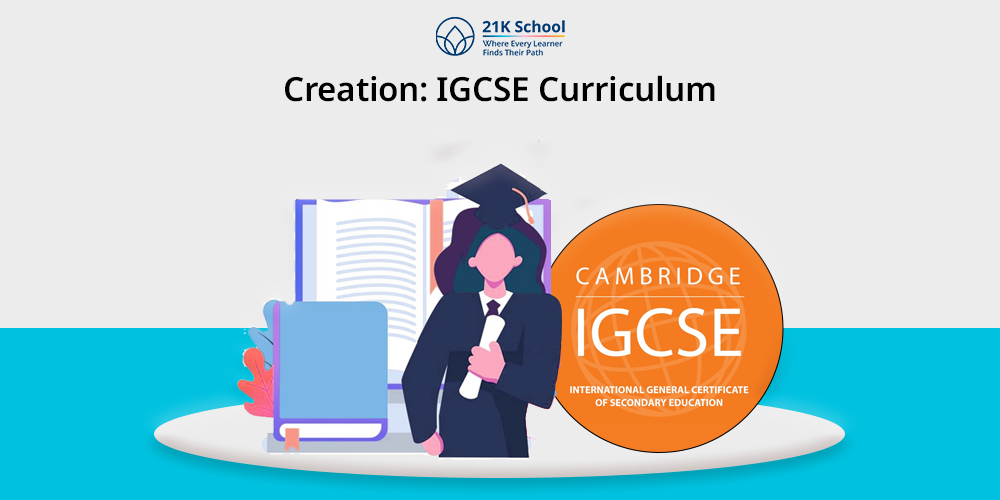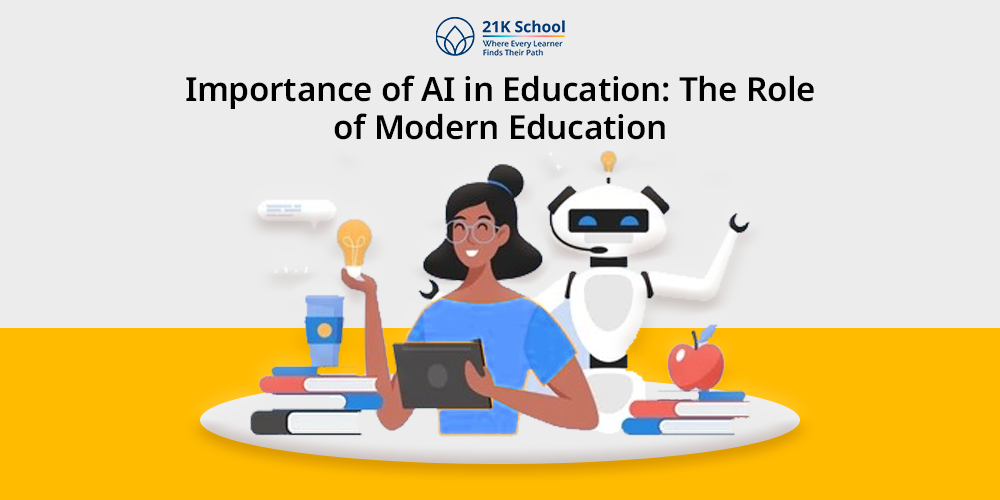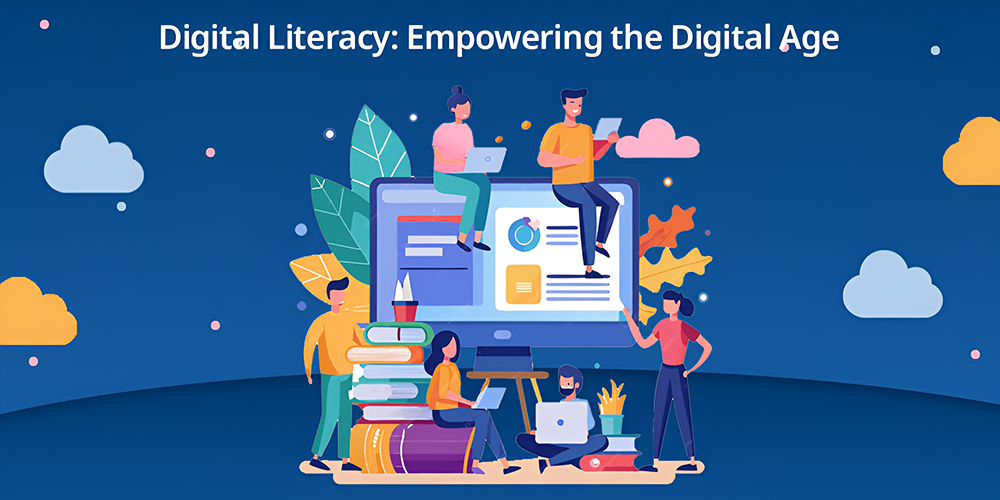
Digital literacy is a promise to the tech- driven world, that a world would be a better place to connect, learn and grow through technology.
It is a skill that goes beyond just knowing how to use smart phones, tablets and laptops. Also, it is for everyone regardless of age, location, or background.
It’s a combination of things that support technology in every environment and makes it equitable. It’s believed that there are no better options than integrating technology in our lives, and digital literacy shapes it well.
It needs a lot of confidence to navigate through the digital world, sometimes it’s also about making informed decisions and unlocking better opportunities at your fingertip.
In a world where everything is so quick and fast paced, being active digitally and technically advanced is no more just an option – it’s rather an essential skill that empowers you to access global knowledge.
Digital literacy reaches to real depths of lives healing and affecting aspects that helps one grow professionally and be literally more aware of the environment around.
It also comes with a set of challenges for people not very well equipped with the skill, thus making it an essential life skill.
As we move ahead in this blog, we will be reading about every knicks and crack of digital literacy, right from importance to its existence and the core components that make it so viable in the current situation.
Table of Contents
- What is Digital Literacy?
- What is Digital Literacy in Education?
- Importance of Digital Literacy
- Why Digital Literacy Skills are Important for Students
- Uses of Digital Literacy
- Types of Digital Literacy and Their Real-World Impact
- Characteristics of Digital Literacy
- Teaching Digital Literacy Skills
- Advantages of Digital Literacy
- Challenges in Achieving Digital Literacy and Their Solutions
- Conclusion
What is Digital Literacy?
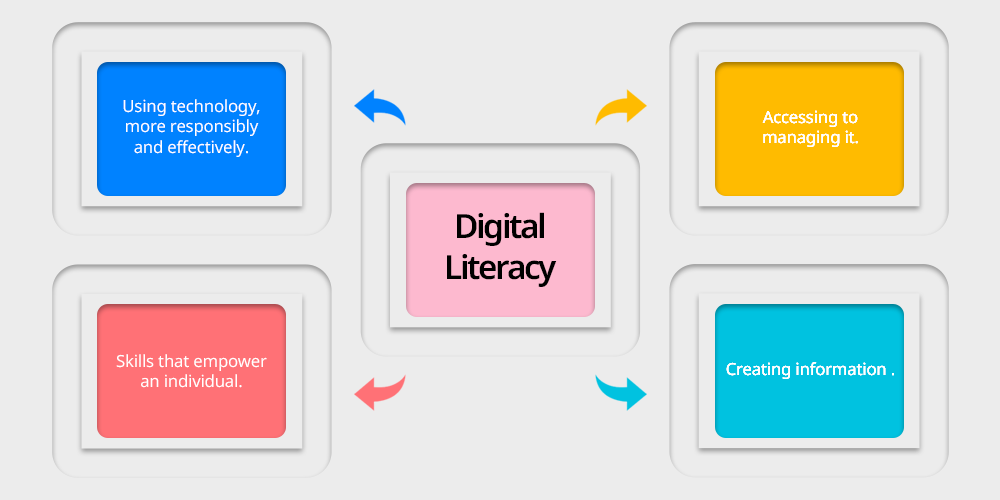
Digital literacy is not just about using technology, it’s about using it more responsibly and effectively.
Also, it is not just about using the internet the right way rather it’s about every digital tool, technology and platform.
The use here is also not restricted; it can be from accessing to managing it, evaluating its impact or can even be about creating information on the digital landscape.
It holds a lot of responsibility.
It talks about the skills that empower an individual with the power of navigating through the rough and advanced roads of internet, software and digital communication making it a credible source of information — only based on the realities, facts and data.
Not to forget, it is very easy to get misguided online, under any influence whether it be lack of exposure of fear around the scammers.
What is Digital Literacy in Education?
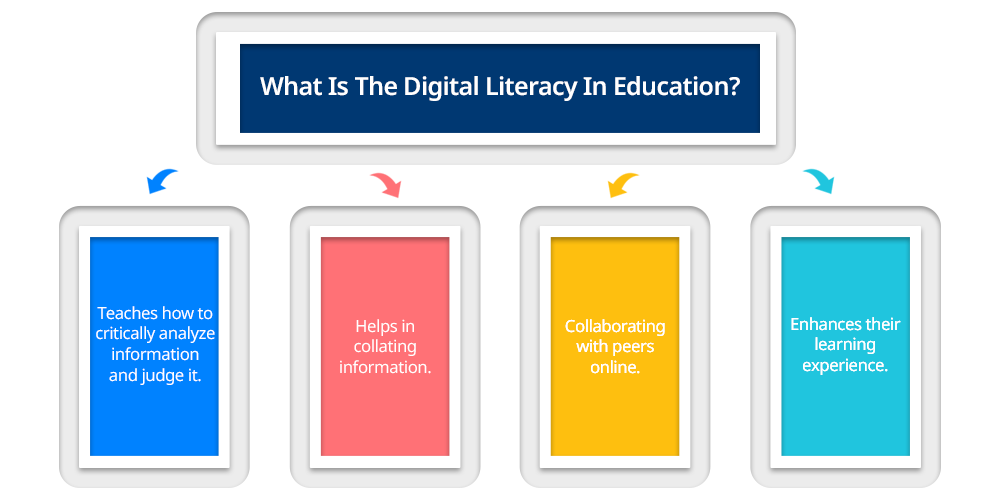
Digital literacy in education is a lifelong skill, well suited for this generation and the coming generations.
It helps them understand the skillful and wise use of technology as a tool of learning and also teaches them how to not exploit it for further distractions and ulterior motives.
Why is it so important?
Especially for learners, it is very important to teach them how to critically analyze information and judge it on realities.
Digital literacy helps them in collating information, collaborating with peers online and it enhances their learning experience by introducing them to digital or virtual learning platforms.
Considering how things have changed in past decades it is a necessary skill every student should be well-equipped with. It is as important as any other traditional skill like; reading or writing.
Importance of Digital Literacy
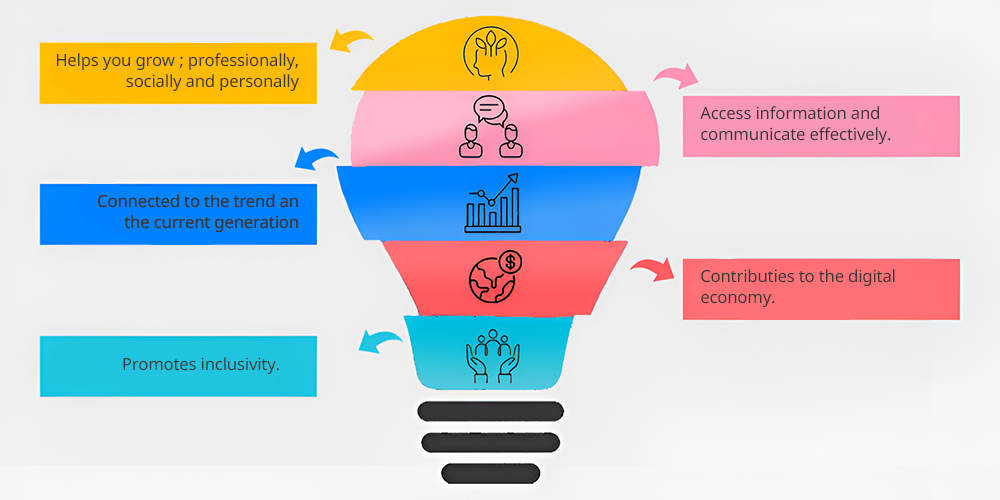
What all things are available online — grocery, hospital appointments, shopping experiences, schools moreover everything.
In a world that is so technologically advanced and dominated by the online presence of every sector and every unit on the digital landscape, isn’t it important to serve digital literacy as a skill that will help you grow ; professionally , socially and personally making you more connected to the trend and the current generation?
Digital literacy empowers every individual to access information and communicate effectively being an active participant of the digital world and contributing to the digital economy.
For some people and communities, digital literacy promotes inclusivity and bridges the gap between the privileged and those who often miss out on opportunities due to lack of resources.
Why Digital Literacy Skills are Important for Students
It is very important to understand why we are discussing it….. Afterall how does it affect learners?
From a very young age learners nowadays are exposed to the digital world and thus, they know alot more about it than the older generation.
But, it’s not just about the mobile screens that we are talking about, here we are discussing digital literacy as a skill.
It prepares learners for the real world and workforce – making them more aware about the opportunities and job demands that now exist around them with demands in digital skills across nearly every possible industry one can choose for; marketing, coding, sales, human resource or even business.
Students exposed to the online world tend to learn how to access resources and information better when it comes to credibility and even develop a skill to think critically and evaluate the results of their searches from the pool of online information available.
It also contributes to collaboration and communication skills across geographical boundaries as the internet now allows one to communicate and interact across the globe, which promotes teamwork and cultural diversity being normalised – inclusivity in lives.
It is very important to teach learners about cyberbullying, cybersecurity and possible threats that may exist in the digital landscape – so, simply educate them about safe online practices, and make them more aware of the digital world.
Uses of Digital Literacy
Digital literacy can be used in various sectors of the society empowering everyone involved and exposed to: being a life skill it brings in good beliefs and teaches only values that reflect well on life when implemented and taught well.
For learners, in the Education sector it provides them access to e-learning platforms and also helps them easy availability of resources required — education anytime and anywhere.
When a learner grows with time and we look for another stage it helps every individual employed, in their professional journey.
It facilitates easy job searches and promotes skills development through online platforms that helps them in getting promoted and even job switching. Additionally it contributes to one’s online application journey.
It helps individuals in improving their personal and professional communication skills along with developing a basic social and civic sense in them.
This helps them be more aware of the environment and makes them more sensitive towards the diversity and even makes them aware with concepts of special needs.
With digital tools and active participation, everything is possible.
Types of Digital Literacy and Their Real-World Impact
| Type of Digital Literacy | Why It Matters | What It Looks Like in Everyday Life |
| Functional Literacy | Forms the foundation for using any digital tool or platform effectively. Making sure everybody knows the core of the function. – the basic | It’s very similar to saying that — “I know how to turn on my device, navigate apps, and send an email.” |
| Media Literacy | Helps users critically analyze digital media and avoid falling for fake news or misinformation.It is like being learned enough to make informed and conscious decision. | Simply believing in yourself and concluding that — “I can tell when a post is biased or when content is being shared to mislead.” |
| Information Literacy | Empowers individuals to access and apply credible information for education, work, or personal growth.Understanding the difference between data and credible sources of data. It is equally important to apply data in real life practices, Effectively and efficiently. | “I can find reliable sources for my research and know how to use the data I find.” — not everyone is smart enough to make this choice and use it wisely even being able to access the data. |
| Safety Literacy | Ensures users can safeguard their digital identities and stay safe in an increasingly connected world. | “I know how to protect my passwords and recognize phishing attempts.” |
Characteristics of Digital Literacy
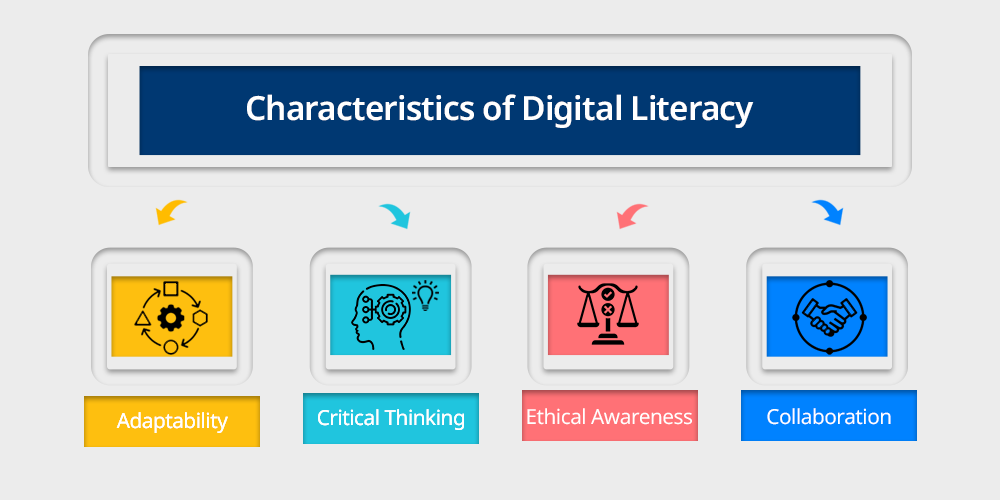
Digital literacy is more than just a technical knowledge for learners, rather when we learn about its real life implications, we understand how important it is to be digitally aware and what it builds into on a personal level.
Foundational characteristic of digital literacy include:
- Adaptability
- Critical Thinking
- Ethical Awareness
- Collaboration
Every characteristic has a very dominant role in a learner’s life where adaptability ensures individuals embrace new tools, gadgets, platforms and technologies in their life for personal and professional upliftment.
While critical thinking helps in evaluating the credibility of online content available for the learners that they refer to, in the process of learning.
These two are not just characteristic, if we look at it from a skill development perspective, these are the two of the basic skills that a student should be well-equipped before graduating and enrolling into college for higher studies.
Similarly, ethical awareness makes learners responsible for digital behavior and teaches them the value of being sensible and accountable for their actions in a digital landscape, and collaboration encourages teamwork, it’s not a new skill but is very important for a learners, especially when taught through digital platforms— these skills are indispensable in today’s interconnected world.
Teaching Digital Literacy Skills
Teaching digital literacy is a responsible and a very difficult task overall, though it is a thoughtful approach of empowering every part of the society with the hands-on knowledge of technology and digital platform, essentially required to practice in daily life.
It holds a lot of relevance in today’s world and even in such models it is tailor made for people to teach them better and make sure everybody is involved in the learning process.
There are some way teachings can be made accessible for people such as;
- Interactive Learning
- Real-Life Scenarios
- Age-Specific Training
- Community Outreach
Similarly, there are many examples of digital literacy being practiced everyday as : digital literacy is used for Creating and Sharing Documents, using tools and platforms like Google Docs.
Also for Social Media Management, digital literacy is used for running campaigns or creating content that are engaging and interactive.
People also use literacy to carry out their Online Research by accessing academic journals and credible websites, this is even done on a professional level to make more informed decisions and keep track of trends.
One of the most important aspects is Digital Financial Literacy, where one is introduced to features like UPI, net banking, or e-wallets — using them is convenient, easy and is equally risky if not learned well.
Advantages of Digital Literacy
There are a lot of advantages to digital literacy, but it is important to understand that these advantages are only beneficial if they are well taught and are made equally accessible for everyone.
Some of basic advantages attached to digital literacy are:
1. Enhancing Educational Opportunities
As it is well known that by the introduction of the internet, education has now been more accessible for people across all demographics, as it provides access to global learning resources, as and when required with merely no restrictions.
2. Boosting Employability and Career Growth
Digital literacy being a lifelong skill, it helps individuals with skills, crucially important for the digital economy.
Especially for the environment where fraud, scams and other threats related to monetary transactions have been dominant, digital literacy can help us cater to all these problems.
3. Promoting Social and Civic Engagement
Digital literacy encourages participation in digital governance and activism. Right from starting a trend to following one it’s all a cake walk now.
This awareness has been making the world a better place by incorporating inclusivity into our cultures and making people more sensitive to their peers and others in the society, whether or not related — doesn’t matter.
4. Fostering Lifelong Learning
It is not just for a day or two that digital literacy will be helpful, it’s a journey that keeps evolving and keeps getting better.
Digital literacy enables continuous learning through online platforms and that is nurtured by the ever evolving environment of the digital landscape itself.
Challenges in Achieving Digital Literacy and Their Solutions
| Challenge | What It Feels Like | Possible Solutions |
| Access to Technology and Infrastructure | What it feels like in a talking tone, it would be: “How can I keep up when I don’t even have access to the basics?” | Invest in affordable devices, improve internet connectivity, and set up community tech hubs. |
| Generational and Socio-Economic Gaps | People often feel that: “Technology feels overwhelming, and they don’t think it’s meant for someone like them.” | Possible solutions could be to offer hands-on, simplified training programs for older adults and subsidize tech education for low-income families, basically making technology as accessible as possible. |
| Combating Digital Misinformation | “It’s hard to tell what’s true when everything online seems convincing.” — it’s very similar to what our parents say, forwarding information to us on different social media platforms. | Educate users through workshops and campaigns about spotting credible sources and fact-checking information. |
Conclusion
Digital literacy is a skill required by every individual in the 21st century, which helps them in shaping individuals’ lives, where they learn, work and grow with the help of digital literacy.
It’s a lifelong skill that helps them be active and takes their efforts positively to challenge the traditional methods of getting things done, and putting efforts to evolve with digital literacy.
For a country like India – digital literacy is very crucial, as this can help us create a more unified, inclusive and empowered society. This is only possible if we take in concern all the gaps and profoundly for the solutions.

